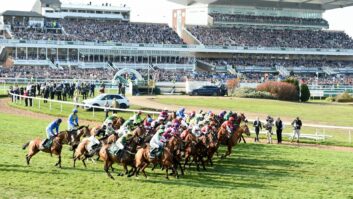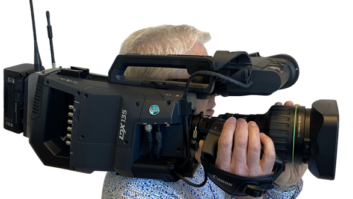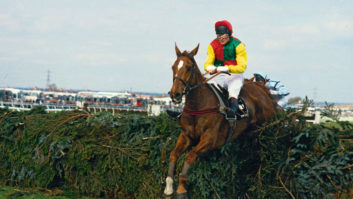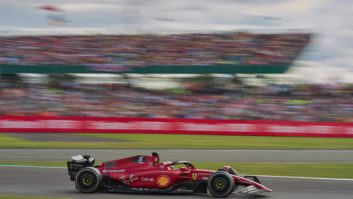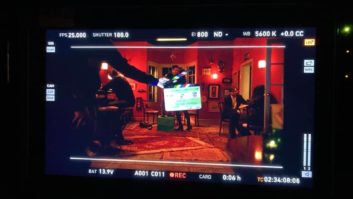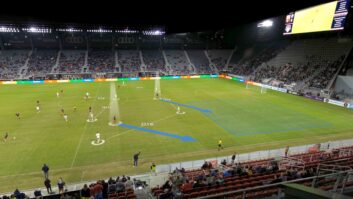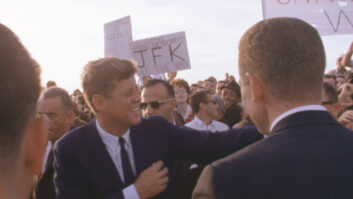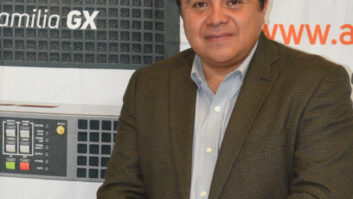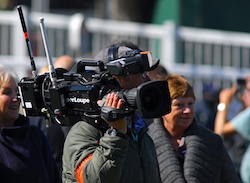
Channel 4 Racing broadcast the Grand National from Aintree recently, its first time covering the iconic horseracing event, and it wanted to expand the scale of its coverage by using more wireless cameras than ever before. This meant a lot of work for wireless camera specialists Broadcast RF. “It’s a new venue for us, so we had to start from scratch,” said its Technical Project Manager, Nick Fuller, who looked after the RF implementation for the Grand National. Broadcast RF is the exclusive RF supplier to NEP Visions for the Channel 4 horseracing coverage, which, since the new deal was established in 2013, now includes The Grand National, The Epsom Derby and Royal Ascot – ‘Crown Jewel’ events that have been broadcast on the BBC for more than 50 years. “Generally, at race courses, we use a fibre network [to link receive points to the a central control point to feed the receiver/decoders], so we had to determine what fibre cables had to be put in as part of a permanent installation [by NEP Visions], even though we only go there, at most, twice a year, it’s a good basis for us to build a receive infrastructure on,” said Fuller. There were also some temporary cables installed. Visions also installed some fibre for its own use, such as from the Channel 4 studio to the OB compound. “The other big challenge is the physical size of the race course. It is more than 1km from the Grandstand to the far side, which is bigger than other race courses we regularly cover.” There are two commentary positions on the course (one on the straight just after the Grand National start line and the other on the far side), large scaffold structures ideal for positioning antennae, and linked into the permanent fibre by temporary cables. Further antennae were positioned on the roof of the Grandstand, the C4 studio roof (which was ideal for the handheld camera in the Grandstand), on the back of the stands (for the parade ring) and on the weighing room roof (for parade ring and Winner’s Enclosure). It was also able to provide coverage of the stables, an area that hadn’t previously been covered by live links. In all, it had 26 antennae at six points, with the RF signals sent back via fibre to an array of Vislink 2134 and newer 2174 HD receivers. “Both the racecourse and the freelancers who have worked the Grand National in previous years were quick to offer words of advice regarding issues with radio camera coverage and so-called known ‘dead spots’ at Aintree,” said Jon Harris, NEP Visions’ Unit Manager. “I was pleased that this wasn’t an issue for us, especially as this is the first year that C4 have covered possibly the most watched horse race,” which the racecourse claims gets a worldwide audience of 600m.
Broadcast RF provided 13 wireless camera systems. These included units for the Twin Squirrel helicopter with Cineflex camera, a Camcat tracking wire cam, two tracking vehicles with gyro-stabilised cameras (one of which was a Servicevision Scorpio crane arm fitted with an HD Cineflex V14 for high tracking shots, the other a new tracking vehicle, which debuted at Cheltenham, with an HD Gyron 935 Plus mount), and a roving Superloupe ultra slo-mo camera. All these were supplied by Aerial Camera Systems, which also supplied a SmartHead remote head fitted with a Sony P1 Camera for shots in the weighing room, and various minicams that were used on some of the fences, including the infamous Beechers Brook. The rest of the wireless systems were on two Steadicams and five rovingreporter cameras.
They hadn’t used Digital Video Sud’s Superloupe before, but “Channel 4 loved it,” said Fuller. To ensure the EVS operators in the truck had the control they required to play back the replays, Broadcast RF created a bespoke remote control system using a combination of wireless IP technology and its own data systems. The DVS camera can shoot at up to 2,500 frames per second, and offers instant replay and a speed-break effect via the EVS Hypermotion controller. It has a 12-bit CMOS 1920×1080 sensor, and, at 500fps has high sensitivity of 2000lux at F7. It weighs 7kg including Sony viewfinder. The Superloupe is also being used on the Champions League Final in May. The CamCat was set up infield of the home straight, rigged parallel to the Grandstand, to track the horses over the last few jumps and past the finishing line. It ran 750m along the course and was suspended from cranes at either end, so if anything went wrong, or batteries needed to be changed, they had to go up in a cherry picker. Although the Grand National is the big race (the UK’s biggest), they were there to cover the three days of racing (with several races each day), which gave them plenty of time to fine tune the systems before the main event. Broadcast RF had previously worked with Channel 4, IMG (the production company) and NEP Visions on the Cheltenham Festival and other racing events, but this year is the first of a C4’s four-year contract to broadcast Aintree – previously the BBC had broadcast the Grand National. “It was an excellent three-day meeting at Aintree, where everything worked outstandingly,” said Denise Large, IMG’s Programme Director, Channel 4 Racing. “Technically it was brilliant and was organised with great precision. The wireless cameras went into areas never covered by the BBC, namely the stables. The performance of the tracking cameras, helicopter [and] hand helds were a credit to Broadcast RF both at the Cheltenham Festival and Aintree.” Viewer numbers for the UK’s biggest race warranted the comprehensive coverage, with an audience of about 8.9 million, representing 61% of UK viewers at 4.15pm for the Grand National. Judging from social media networks, the audience were more than happy with the Channel 4 coverage. Band of bothers “The RF requirements were a particular challenge this year. In February we lost the 2.5-2.7GHz band [to mobile network use],” said Fuller. “Which had the effect of squeezing everybody into not enough channels,” added Broadcast RF’s Sales Director, Chris Brandrick. Previously they would have had access to another 19 channels in this band, but instead they had just 11 channels to call on in the 2.0-2.3GHz frequency. There are a total of 20 channels available in this band, but eight of those are permanently assigned to the UK’s news broadcasters, who need frequency at a moment’s notice. What was left “wasn’t’ enough frequency to do all the cameras we had at Aintree,” said Fuller. “So, we had to move two channels to the 3.5GHz band, which meant we couldn’t share a single infrastructure, so we had to duplicate everything.” He is worried that this is just a precursor of further changes to follow. The Ministry of Defence, which has primary call over these frequencies in the UK, is set to relinquish large portions of its spectrum in 2014, and Brandrick believes this band will also be sold off to mobile phone networks. “It may mean us having to re-equip to move up spectrum to 5GHz or 7GHz bands, and those frequency bands don’t work as well for mobile cameras,” as they don’t offer the distance or ability to work around corners as the lower bands. “If we have to go with that band, it may mean an even bigger antenna infrastructure to get the same performance,” he added. The Vision thing NEP Visions had two scanners on site (HD2 & HD4), both with double-expanding sides. This was “to give us enough vision space for the 50 cameras that needed processing and racking, but also to assist with the additional sound requirements,” explained Harris. “Every fence of the Grand National had effects microphones and there were a number of crowd mics available at various areas of the course, together with numerous camera mics on the radio cams. Therefore, a dedicated effects submix was setup to feed the main mix, which took care of everything else. The second production area was also used for ‘the rerun’, which is a specific part of the Grand National coverage where alternative camera angles of each fence are replayed and analysed in sequence. This is a complex VT operation and therefore has a dedicated production team.” Pegasus is its studio dedicated to C4 Racing, and provides a mobile five-camera studio, with full lighting rig and studio facilities for up to five presenters. “There is an interactive touchscreen table providing VT integration and analysis facilities for the presentation team,” added Harris. “With a large window for a backdrop, the use of polarising filters enables us to vary the light levels for the cameras depending on the weather. The studio was located near to a busy public area so allowed the viewers to get a real feel for the event. There is also a roof garden, which provides a great in-vision position for presenter links Visions also had two of its multi-purpose Voyager Portakabin-based units, which were used to house the seven edit suites that Visions provided, and its Mercury VT truck with eight EVS LSM machines. Each transmission day it did a Morning Line Programme and then did four hours of racing coverage in the afternoon. It also provided a highlights programs for the Grand National.
C4 clears 2nd Screen with SyncNow Channel 4 also launched a Horse Tracker 2nd screen app allow viewers to track the position and speed of the horses, for the first time. The free app, which was available to download from the Apple App Store, utilized Civolution’s SyncNow for 2nd screen to ensure that the Horse Tracker synchronized perfectly with the action on the viewer’s TV. This was particularly critical in a race with a large number of entrants and where positions can change so quickly. “This was a great opportunity to give our viewers a whole new perspective on the world’s most famous horse race,” said James Rutherford, Channel 4’s Multiplatform Commissioner for Sport. “In the heat of the live action it can often be difficult for viewers to track the position of their horses. Using realtime data from the course combined with the latest audio-watermarking technology from Civolution allowed us to give viewers the chance to exactly track their horses alongside the television coverage.” The Horse Tracker app uses Monterosa’s LViS second screen technology and TurfTrax data to allow users to access live race information synchronised with their TV coverage of the race – including the position of horses, as well as the speed of their selection; distance to the next horse and to the finish. The app allows users to choose to track one horse, a multiple selection, or track the live positions of all the horses in a race. The app covered 12 of the 15 televised races from the 2013 Grand National meeting. David Fox www.aerialcamerasystems.comwww.broadcastrf.comwww.civolution.comwww.dvs-sport.tvwww.visions-ob.com
